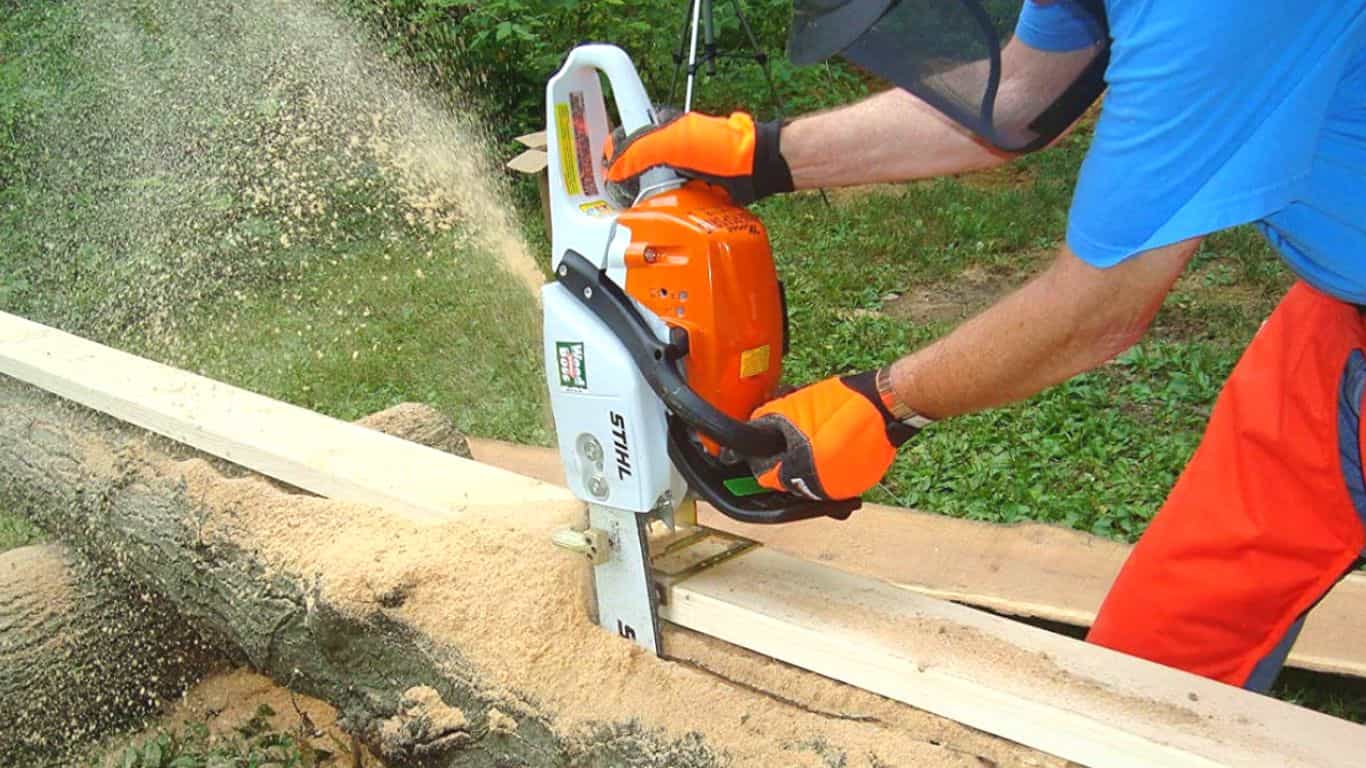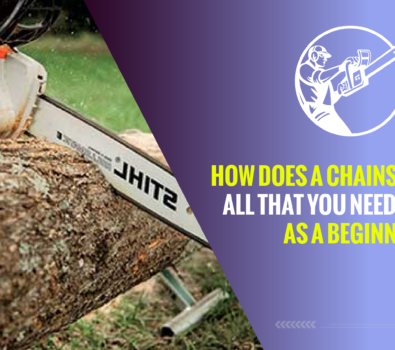If you’re a part of the chainsaw world, and your job is cutting large logs of wood, this guide is to make your job a lot easier!
Chainsaw mills are a great help for chainsaw users. I’ve been into cutting wood for years now and I think chainsaw mills aren’t a thing you shouldn’t have. With a chainsaw mill, it’s super easy and convenient to handle large logs of wood and cut them into planks. And the best part is, YOU CAN BUILD YOUR OWN CHAINSAW MILL AT HOME. Yes, you heard it right! But, how to build a chainsaw mill?
There’s no need to get a professional hired for this. All you need to know is a bit of DIY and you can build a chainsaw mill with the materials easily available to everyone and everywhere. Compared to a bandsaw or hiring a wood processor, building it by yourself at home can save you a lot of money by converting unwanted logs into something useful.
In this article, we’ll be guiding you through the complete process homemade chainsaw mill. Let’s dive in!
What Are Chainsaw Mills Used for?
Chainsaw mills are used to convert large logs into lumber or useful planks or boards. In simpler words, you can say that they convert wood into a useful form, may it be for making furniture, construction, or other such purposes. They are great tools and many homeowners and professionals have them for making their cutting jobs easier.
What Tools and Materials Do You Need for Making a Chainsaw Mill?
For the tools, you’ll need:
- A chainsaw
- A circular saw
- Guide rails and wedges
- A drilling machine
- Screwdriver, wrench, and other related tools
For the materials, here’s what’s required.
- ¾-inch plywood (2 inches x 6 inches)
- 1-inch x 12 inches (two 6-inch lengths)
- 2 inches x 4 inches (around 18 inches in total)
- Screws

Build Your Chainsaw Mill with Us in Five Easy Steps!
Let’s build a wooden chainsaw mill together! Here are the steps that are to be followed:
- The construction of rails and supports
- Attaching the milling chainsaw to the sled
- Putting everything together
- Attaching anchors
- Running the chainsaw mill
The Construction of Rails and Support
The very step is building up the rails and support. It provides the base for the process as well as for the chainsaw mill that is yet to be constructed. The purpose of these guide rails is to guide the chainsaw as it slides along.
- The 1×12 should be cut in two equal pieces, with the 12-inch margin left for clearance on both sides.
- You now need to cut the 4 pieces of 2×4 into 11.5-inch lengths. It will assist in mounting the rails and it will support the braces at the ends.
- While cutting, keep two pieces of 2 x 4, 3 inches shorter than one piece of 1 x 12.
- Now, by screwing from the top of the 1 x 12, screw the 2” x 4” piece of wood on the bottom or end of the 1 x 12 using a screwdriver.
Attaching the Milling Chainsaw to the Sled
Now that you’ve constructed the guide rails and support, the next step is building the sled and then attaching the milling chainsaw to it. The purpose of this sled is to help move the chainsaw along the guide rail of the 1 x 12 chainsaw mill.
Sled and chainsaw mills will move together. No matter what size chainsaw mill you have, building a sled is necessary.

Here’s how you construct it.
- Prepare the plywood by cutting it into 14.5 inches x 8 inches.
- Prepare two lengths of 2×4 that are 8 inches long.
- Now, at the opposite end of the plywood, screw the two 2x4s to the bottom.
- Finally, fix the 1×12 between the 2×4.
If you want to make it even better, you can attach the chainsaw to the plywood so that it moves perpendicular to the rails you built from 1 x 12. Remember, there should be a parallel plane between the 1 x 12 and the bar. To ensure that your sawmill is stable, keep the chainsaw attached to the sled.
It is very important to ensure that you’ve fixed the saw properly. It may go wrong if it’s not done correctly. Also, build handle support because by doing so, you’d be able to get the job done a lot more easily.
Additionally, just below the bar, you can add 2 x 4 for support, and it’ll hold the blade in place. Also, you might now know this already that you will only be moving the firewood chainsaw on the sled, so support the handle as well.
Putting Everything Together
You’re done making the rails and support, you’re done making the sled. Now it’s time to assemble it all together.
- With the help of screws, connect two 24 inches x 30 inches plywood parts to the end supports.
- Then prepare the log support and rails that are parallel and level. Depending on the height adjustment, you can alter the cut thickness.
Attaching Anchors
This step is for the maximum safety of the user. Chainsaws are super powerful and so, dangerous as well if not handled properly. Therefore, if you want to build a homemade chainsaw mill, you should build support that prevents the chainsaw log from rolling. You can reduce cutting errors and waste by adding a 2 x 4 support and screwing the log.
Running the Chainsaw Mill
Now is the time to test what you’ve built! Using a chainsaw with a long bar is an excellent way to ensure that you will get an accurate cut. We recommend using a long chainsaw bar because you can cut a perfectly straight line through the entire log with it. Furthermore, it is important to make sure the sled and chainsaw have enough space both behind and in front.
If you are a newbie to chainsaw milling, you don’t have to rush since it may be challenging. Just be patient and practice things. Also, before you begin your next project, you should clean the boards and oil the chainsaw. That’s extremely important for a better and smoother experience.
Chainsaw Mill: How Do I Use It?
Wondering how to use a chainsaw mill? You might be a beginner here but nothing to worry about. Even if using a chainsaw mill seems a bit daunting in the start, it won’t seem the same when you use it twice or thrice.
Here’s what you need to know about the use of a chainsaw mill.
- Put the branches on a smooth surface after cutting them from the log. We recommend you use the flat log surface for a straighter start. The guide rails can be positioned across the log using the leveling machine, then screwed into place.
- It is advised to move the sawmill under the guide rails in order to avoid hitting the mill. Due to the fact that you do not have to remove a lot of wood, you can make the first cut easily.
- Now proceed to the next step which is the second cut after you have made the first cut. But take out the guide rails first. It is recommended that you set the thickness lever between 2 and 2.5 inches or as needed. It should, however, be easy to handle when you remove it.
- Slab by slab, continue with your cutting process. There’s still no need for the guide rails. They were meant for the start-up only.
- Remember, towards the end of the log, you might encounter difficulties. Thus, it would be better to place a prop just beneath the log.
TIP: As soon as you have finished cutting the slabs or boards, place them in a safe place until they have dried! Using the chainsaw lumber-cutting guide will help you if you run into any difficulties while using the chainsaw mill.
How is Using a Chainsaw Mill Advantageous?
Chainsaw mills are very efficient and super helpful in getting the job done rightly and accurately. Once you start using a chainsaw mill, you’d know it’s never better to work without it.
Firstly, when it’s affordable and can be built at home, what could be non-beneficial about it? Of course, nothing. Chainsaw mills are a very budget-friendly option and a great way of dealing with your large wood logs.
Large trees can be easily cut with sawmills. In case you didn’t know already, a sawmill can easily cut logs 20-69 inches in diameter which means you can literally cut any size of wood log. Having the flexibility to operate the sawmills simplifies the process even more.
By using mills, you can accomplish all those tasks and projects that would be difficult to accomplish otherwise. You can easily cut the wood into smaller pieces which can then be used for various purposed in various fields. In addition, raw materials can be customized according to your specifications.
How to Make a Chainsaw Mill – FAQs
Conclusion
In a nutshell, you can build your own chainsaw mill at home if you know how to handle a chainsaw but make sure you take the necessary safety precautions. When you build a DIY chainsaw mill, be sure to exercise extra caution as chainsaws can be very dangerous at times and safety should always come first when doing any DIY project.
Also, if you get to do this well, you will be able to deal with any fallen or felled trees on your property in an inexpensive and effective manner. And a wood logger like me won’t be asking for more!




